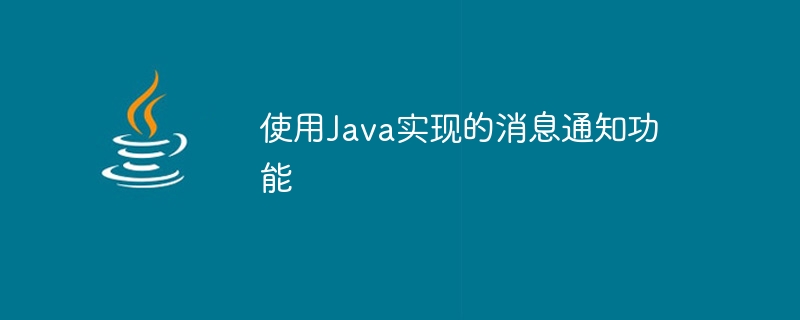

Message notification function implemented using Java
With the development of the mobile Internet and the popularity of smart devices, message notifications have become essential in modern people’s daily lives function. Whether it is new message reminders on social media or push notifications on mobile applications, an efficient and reliable message notification system is indispensable. In this article, we will introduce how to use Java to implement a simple message notification function.
First, we need to define a message notification interface, which includes methods for sending messages, subscribing to messages, and unsubscribing to messages. The following is a simple definition:
public interface Notification {
void sendMessage(String message);
void subscribe();
void unsubscribe();
}Then, we can implement the methods in the interface and create a specific message notification class. In this example, we will use Email and SMS as the message sending methods. The following is a code example of the specific implementation:
public class EmailNotification implements Notification {
@Override
public void sendMessage(String message) {
// 实现发送邮件的逻辑
System.out.println("发送邮件通知:" + message);
}
@Override
public void subscribe() {
// 实现订阅邮件通知的逻辑
System.out.println("订阅邮件通知");
}
@Override
public void unsubscribe() {
// 实现取消订阅邮件通知的逻辑
System.out.println("取消订阅邮件通知");
}
}
public class SMSNotification implements Notification {
@Override
public void sendMessage(String message) {
// 实现发送短信的逻辑
System.out.println("发送短信通知:" + message);
}
@Override
public void subscribe() {
// 实现订阅短信通知的逻辑
System.out.println("订阅短信通知");
}
@Override
public void unsubscribe() {
// 实现取消订阅短信通知的逻辑
System.out.println("取消订阅短信通知");
}
}Now, we can use these implementation classes to send message notifications. The following is a simple example:
public class Main {
public static void main(String[] args) {
Notification emailNotification = new EmailNotification();
emailNotification.subscribe();
emailNotification.sendMessage("Hello, World!");
emailNotification.unsubscribe();
Notification smsNotification = new SMSNotification();
smsNotification.subscribe();
smsNotification.sendMessage("Hello, Java!");
smsNotification.unsubscribe();
}
}Running the above code will output the following results:
订阅邮件通知 发送邮件通知:Hello, World! 取消订阅邮件通知 订阅短信通知 发送短信通知:Hello, Java! 取消订阅短信通知
As you can see, we have successfully implemented a simple message notification function using Java. Of course, in actual development, more complex functions and more message sending methods may be involved. However, the sample code above already provides us with a foundation that we can extend and improve based on our actual needs.
To summarize, message notifications are one of the indispensable features in modern applications. By using the Java programming language, we can easily implement a simple and efficient message notification function. Hope this article is helpful to everyone!
The above is the detailed content of Message notification function implemented using Java. For more information, please follow other related articles on the PHP Chinese website!
